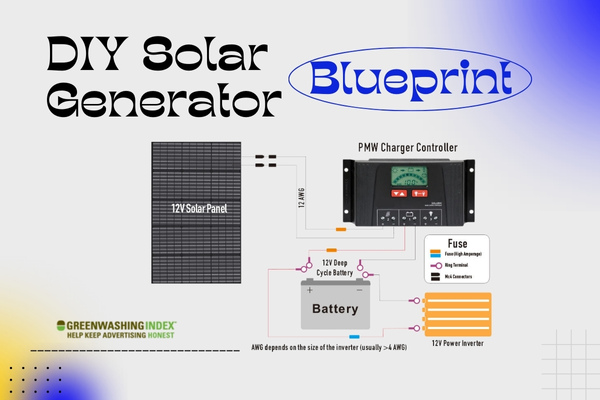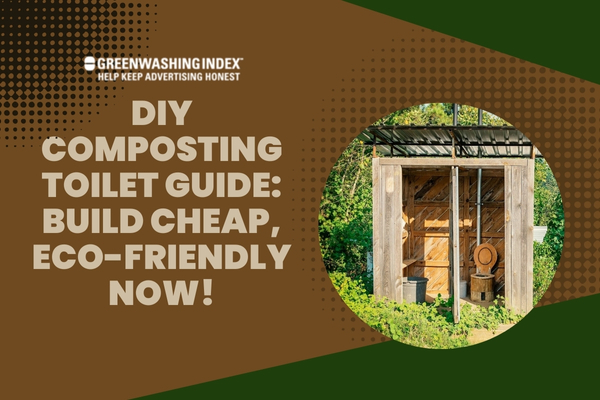Sometimes, I think about how to keep my lights on when the power dashes away. Imagine if you had a magic box that could turn sunshine into power for your gadgets anytime, anywhere. The truth is, that’s no fairytale – it’s called a DIY Solar Generator, and making one is possibly within your reach! No more fears of being left in the dark during an outage or while camping in the woods.
Ever wondered how to convert those bright golden rays into electricity that powers up your entire camping site or backyard shed? A DIY Solar Generator can be the hero you’re looking for, offering a green and sustainable solution right at your doorstep. And guess what? Building it may not be as complicated as you think! You’ll just need some solar panels reaching out to kiss the sunlight, batteries holding onto that sweet energy like a squirrel with nuts for winter, and a few more bits and bobs to tie it all together.
What You’ll Learn Here:
- Step-by-simple-step guide to crafting your sun-powered beast
- Secret ingredients list for cooking up energy independence
- Foolproof ways to ensure every ray of sun fills up your power banks
Understanding the Basic Principles of a DIY Solar Generator
To build your own DIY solar generator, it helps to know how it really works. I’ll break it down in simple terms so you can see just how easy the process is.
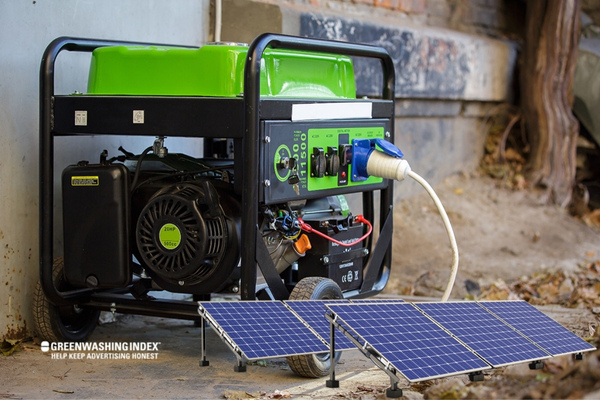
Solar Power Fundamentals
Solar power is like magic from the sun. The sun shines, and boom, you get electricity. But how? Imagine tiny packets of light called photons hitting a solar panel on a sunny day. These photons have energy, and when they hit the solar panel, they knock electrons loose from atoms inside cells in the panel.
Now, these free electrons are like excited kids in a playground – they want to move and create energy! Solar panels capture these electrons and make them flow in one direction, which creates an electrical current. This current goes through wires to do useful stuff like charging batteries or running your TV!
This is what we call harvesting solar power for generating electricity. And guess what? A DIY solar generator uses this same idea but packages it into something you can use anywhere you need power.
Components of a DIY Solar Generator
When I say building a DIY solar generator isn’t rocket science, I mean it – even though it might sound fancy! Let’s look at all the bits and pieces that go into making one:
- Solar Panels: These are the star players because they catch sunlight and start the whole process.
- Charge Controller: This little gadget makes sure your battery stays happy and doesn’t get too full or too empty by controlling how much juice flows from the panels to the battery.
- Battery: Think of this as your power bank storing all that sun goodness for when there’s no light outside.
- Inverter: Now, here’s where things get cool – an inverter changes direct current (DC) from your battery into alternating current (AC), which is what most of our home gadgets use.
- Wires and Connectors: They’re like roads for electricity, taking it where it needs to go.
It’s pretty amazing when you think about putting all these things together to make your very own source of power that’s friendly to our planet!
By grasping these basics about how sunlight turns into electricity thanks to clever techs like solar panels, controllers, and batteries—and making sense out of AC/DC beyond just knowing they’re rock bands—you’re on track for crafting your house-made bundle of energy: The trusty DIY Solar Generator!
Essential Tools and Materials for Building Your DIY Solar Generator
Creating a DIY solar generator requires both the right tools and materials. Let’s dive into what you’ll need to complete this project successfully.
Necessary Tools
For anyone keen to build their own solar generator, here’s a list of tools you’re going to need. I’ve broken them down in detail for easy understanding:
- Screwdrivers: You’ll want a set with multiple sizes, both flathead and Phillips. These will help you connect components together.
- Wire Cutters/Strippers: Essential for cutting and stripping your wires to the right length.
- Drill with Drill Bits: You’ll need this to create holes for wiring or fixing components in place.
- Wrenches: A good set of wrenches will be helpful when tightening bolts and nuts.
- Soldering Iron: For those connections that might need extra hold, a soldering iron can come in handy.
- Multimeter: An invaluable tool for checking voltages, ensuring everything is working correctly as you assemble your generator.
Please make sure that each tool is in good condition before starting your project to avoid any unnecessary setbacks!
Choosing the Right Materials
When it comes to selecting materials for a DIY solar power setup, quality really matters. I’m going over each component so that you know what to look out for:
- Solar Panels:
- Look for high-efficiency panels to get more power from less sunlight.
- Ensure they’re durable, especially if they will be used outdoors.
- Battery:
- Opt for deep-cycle batteries as they are designed to be discharged and recharged many times — perfect for storing solar energy.
- Check the battery capacity; it determines how much power you can store.
- Inverter:
- Choose an inverter that matches your battery’s voltage output but with some room to spare capacity so it isn’t constantly working at its limits.
- Make sure it has enough outlets if you plan on powering multiple devices.
- Charge Controller:
- A must-have item is needed between the solar panels and the battery; it prevents overcharging, which can damage your battery.
- Cables & Wires:
- Get proper gauge cables (thickness) that handle the electrical load without overheating or efficiency loss.
- UV-resistant cables are great if parts of your setup are exposed to sunlight outside.
- Connectors:
- Invest in quality connectors that ensure secure connections; waterproof ones offer extra protection against elements when outdoor use is intended.
Check reviews when possible, seek advice from others who have built their own systems, and never compromise on safety by choosing less-than-reliable components simply because they cost less upfront!
Always remember that functionality and longevity are keys when picking materials correctly; they ensure not only the system’s performance but also its durability over time!
Step-by-Step Guide to Building a DIY Solar Generator
Building your own solar generator can be rewarding and save money in the long run. Here’s how to get started.
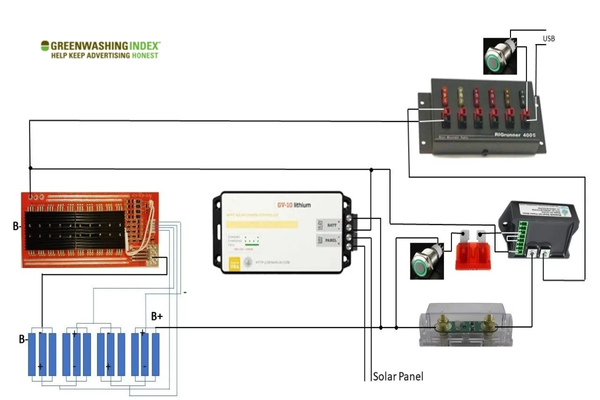
Assembling The Components
To assemble your DIY solar generator, you’ll need a few main parts:
- Solar Panels – These capture sunlight and turn it into electricity.
- Charge Controller – It manages the power going into the battery, protecting it from overcharging.
- Battery – This stores the energy for later use.
- Inverter – Converts stored power from direct current (DC) to alternating current (AC), which is what most home devices use.
- Cables and Connectors – Used to link all components together safely.
Here’s how you put it all together:
- Lay out all your parts in an organized way so that everything is easy to reach.
- Begin by connecting your solar panels to your charge controller using cables with MC4 connectors (these are common in solar setups). Make sure positive connects to positive (+ to +) and negative to negative (-to).
- Next, link the charge controller’s ‘battery’ terminals directly to the battery’s positive and negative terminals. Be careful: always connect the battery last, as it stores power already!
- The final step involves attaching the inverter to your battery – again, match up those positive and negative terminals accurately.
Following these steps should give you a basic but fully functional solar generator setup!
Connecting The Solar Panels To Battery—Power Generation
Now let me break down how you connect those panels:
- Place your solar panels where they can get maximum sunlight – usually on a roof or an open area.
- Use special cables designed for solar connections; they’re typically weather-resistant and durable.
- Run these cables from the back of each panel towards where you will have your charge controller set up.
- Securely fasten cable connectors with care, not forcing them as this could cause damage or poor connections.
Always double-check connections for snugness without any loose wires hanging around, which could pose dangers or reduce efficiency.
Safety And Precaution Measures — Protecting Your Investment
When working with electronics like a solar generator setup, safety must come first:
- Always read manuals for each component before assembly; they contain important safety info!
- Wear protective gear like gloves or goggles if instructed – better safe than sorry!
- Keep water away from all electrical equipment—it doesn’t mix well at all!
- When installing on roofs or high places, work carefully or have someone help hold ladders steady.
By following these rules carefully while you build and maintain your DIY Solar Generator system, you’ll help make sure both you and your investment stay safe!
Optimizing Your DIY Solar Generator For Maximum Output
When I build my own solar generator, one of the most important steps is to make sure that the solar panels are set up just right. If I get this part wrong, my DIY solar power system won’t work as well as it could. To soak up as much sunlight as possible, the panels need to face the right way and angle.
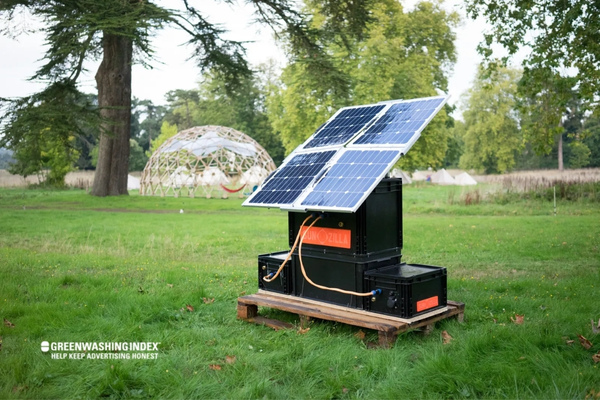
Positioning Your Solar Panels Correctly
First off, I need to check where the sun moves across the sky during the day. In most places, having panels face true south (in the northern hemisphere) or true north (in the southern hemisphere) is best because that’s generally where they’ll get sun for most of the day. But it’s not just about which way they face; how they tilt matters a bunch, too.
The angle should be just so — matching up with my latitude is a good starting point. For example, if I live at 35 degrees latitude, setting my panels at a 35-degree tilt could be spot on — especially if I want good all-year performance from my DIY solar generator.
Another thing: shadows are a big trouble for solar panels. I have to pick a spot without shade from trees or buildings during peak sunlight hours. This might mean putting them high up on a roof or out in an open space.
In summer months, when days are long and sunny, sometimes it helps to adjust things so they’re a little flatter compared to winter, when sunlight is scarce and comes in at a steeper angle.
All this fuss about positioning has one goal: catching every bit of sunlight we can! When done right, it can make a massive difference in how much power gets generated by those precious solar panels on top of our DIY Solar Generator.
Maintenance Tips For Your Generator – Increase Lifespan & Efficiency
Building your own solar generator feels great, but keeping it in shape over time makes sure all that effort pays off for years and years.
I always start by keeping an eye on those solar panels — cleaning them might be simple, but oh boy, does it matter! Dusty or dirty panels can’t grab as much light, so every once in a while (especially after big dust storms or if there’s lots of bird traffic), out comes water and some gentle soap, then rinse them carefully so as not to damage anything.
I also make sure all wires are snug and safe from weather or critters chewing through them. Loose connections? No thanks! Those can cause drops in power or even dangerous sparks.
Battery care is super crucial, too! My setup relies on them storing energy when there’s sun, so making sure they stay healthy keeps me powered even when clouds roll through. That means checking water levels if they’re lead-acid types, making sure terminals aren’t corroded and watching out for any bulging cases, which could mean trouble inside.
Every once in a while, checking bolts and screws ensures everything stays put — shaking loose over time isn’t uncommon with setups like these, especially if you live somewhere windy!
Last but never least, regular testing keeps surprises away; flipping switches measuring output with multimeters gives me confidence that my trusty DIY Solar Generator won’t let me down!
Keeping up good habits with maintenance means less headache down the road because taking care now helps avoid big fixes later — ensuring a longer life for that awesome bit of handiwork. My very own bright, shining DIY Solar Power source!
When you decide to build a DIY solar generator, it’s important to think about the legal stuff, too. You can’t just put together a solar generator without checking if you need to follow some rules. It’s like when you build something in your backyard, sometimes you need a permit, right? Well, it’s kind of the same with making your own solar power setup. Let me explain what you need to look out for:
Do I Need Permission?
Check Your Local Laws: First things first, every place has its own rules. What’s okay where I live might not be alright where you are. So, check with your local government or related authorities to see what they say about building a DIY Solar Generator.
Homeowner Associations: If you live in an area with a homeowner association (HOA), they might have their own rules that say whether or not you can build and install a solar generator.
Safety Regulations
Building codes: A lot of places have what we call ‘building codes.’ These are safety rules that help make sure everything is built strong and doesn’t fall apart or cause any trouble.
Electrical codes: Since we’re talking about electricity here, there are also ‘electrical codes’ to follow. They help prevent fires or any shocks that could hurt someone.
Grid Connection
Utility Company Policies: In case your DIY Solar Generator hooks up to the main power grid – which means it can feed extra power back into the public system – your local utility company might need to know about it. They sometimes have their own guidelines for this kind of thing.
Net Metering Agreement: This is an agreement between you and the utility company that lets them count how much of your solar power goes back into the grid so they can give you credit for it on your bill. But not all places offer this option.
So there it is – before going full speed ahead on building your DIY Solar Power system, do some homework on these points:
- Local zoning laws: Will my city or county allow me to build and install my DIY Solar Generator?
- HOA restrictions: Do I need permission from my homeowner association?
- Building and electrical code compliance: Am I meeting all safety regulations?
- Utility company interconnection requirements: Does my local utility company have policies for connecting my generator?
- Net metering availability: Can I get credit for feeding extra electricity back into the grid?
This stuff isn’t just red tape; it’s there to keep everyone safe and everything running smoothly—kinda like making sure everyone follows traffic lights so we don’t run into each other on the road! Taking care of legal bits before starting can save lots of headaches later!
FAQs
What types of batteries are best suited for a DIY solar generator?
For a DIY solar generator, deep-cycle batteries are great. You might pick AGM, lead-acid, or lithium-ion ones. They’re all strong and last long.
How much does it cost to build a DIY Solar Generator?
The price to make your own solar generator changes. It could be from $200 to over $500. Costs depend on the parts you pick, like battery quality and how big the solar panel is.
What is the average life expectancy of these generators?
A homemade solar generator can last around 25 years if looked after well. But batteries may need changing every 5 to 7 years based on type and use.
Conclusion
Building my own DIY Solar Generator was an empowering journey. It didn’t just help me understand the workings of solar power generation better, but it also gave me a sense of self-reliance. By carefully selecting components, utilizing the right tools, and meticulously following the step-by-step guide, I created a renewable energy solution tailored specifically to my needs.
The joy of generating my own electricity is unmatched, and knowing that I’m contributing to a healthier planet makes the effort all the more rewarding.
Key Takeaway Points
- A clear understanding of solar power basics is essential.
- Proper selection and assembly of components ensure optimal performance.
- Regular maintenance maximizes efficiency and extends your generator’s lifespan.
- Safety precautions are critical throughout the building process.
- Legal considerations should be addressed to avoid future issues.

